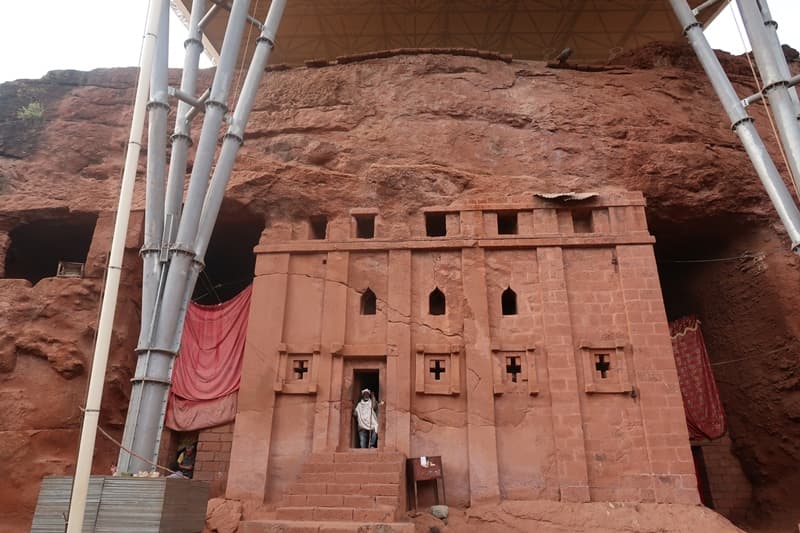As of 2019, Ethiopia is home to nine UNESCO World Heritage Sites. Eight of these sites are cultural, making Simien Mountains the only natural site. In no particular order, here are some of the prominent UNESCO Sites in Ethiopia:
1) Konso Cultural Landscape: Konso, also known as Karati is a town on the Sagan river in southwestern Ethiopia. This site was added to the UNESCO World Heritage Sites tentative list in 1997 because of its supposed cultural significance, and became an official UNESCO site in 2011.
The Konso Cultural Landscape is made up of stone walled terraces and fortified settlements in the Konso highlands. These dry stone terraces protect the soil from erosion by collecting water and creating terraced fields for agriculture. The Konso landscape is also characterized by dry stone walls which reach up to five metres in height.
These fortified settlements on the Konso landscape consists of one to six rounds of dry stone walls made from locally sourced rocks. These settlements were strategically built on high plains and hill summits for defensive purposes.
Also called Pakawle by some neighbours, Konso is also known for the waga sculptures; memorial statues carved out of wood. Its religious traditions and fossil beds also put Konso at the top of the map.

2) Aksum: The ruins of Aksum which was once the heart of ancient Ethiopia and the most powerful state between Rome and Persia lies close to Ethiopia’s northern border. These ruins include giant stelae, royal tombs, monolithic obelisks and ruins of ancient castles which date back from the 1st to the 13th century AD.
This site symbolises the wealth and importance of civilisation of the ancient Aksumite Kingdom. Some trilingual texts in Greek, Sabaean and Ge’ez were found inscribed on stone tablets by King Ezana of the ancient Kingdom of Aksum in 4th AD and have been of great importance to historians.
On this site, ruins of the largest monolithic stela measuring 33 metres in length, lies where it fell, possibly at the time of erection. All monuments on the site are still very authentic although vulnerable due to lack of conservation.
3) Lalibela: Lalibela is a mountainous city in northern Ethiopia known for its distinctive rock-hewn churches dating back to the 12th and 13th century. These 11 monolithic churches have made Lalibela a high place of Ethiopian Christianity and pilgrimage.
In the 12th century, King Lalibela, in an attempt to build a “New Jerusalem” since Muslim conquests prevented pilgrimage to the Holy Land, started the construction of these ancient monolithic churches. These churches were not constructed in the conventional way, but were hewn from rocks.
The rocks were chiselled out to form doors, windows, floors and roofs. One of these churches, Biete Medhani Alem is believed to be the largest monolithic church in the world.
Another church, Biete Ghiorgis has an unusual cross plan. These churches are still preserved in their natural settings with symbols such as a replica of the tomb of Christ, making the site a substitute for the holy places of Jerusalem and Bethlehem and a focus of pilgrimage for Christians.

4) Fasil Ghebbi, Gondar : Gondar is well known for Fasil Ghebbi, an ancient seat of Ethiopian emperors. Within the fortress city of Fasil Ghebbi are palaces, churches, monasteries and unique buildings.
Dominating the site is the immense 17th century palace of Emperor Fasilides which combines Portuguese, Indian and local architectural styles. This fortress city functioned as the centre of the Ethiopian government until 1864.
Still within Gondar and outside the Fasil Ghebbi are other monuments such as the Qaha River with a bathing pavilion which served Emperor Fasilides. Outside the palace compound is also the Debre Berhan Selassie church known for its elaborate murals and ceiling of faces.
Subsequent rulers of Ethiopia constantly improved the architecture of the site as it served as an interface between internal and external cultures manifested not only in the architecture but in painting, literature and the music of the 16th and 17th centuries.
5) Omo Valley: The Lower Valley of Omo is renowned because of the discovery of many fossils there especially Homo gracilis.
This discovery has made the valley of fundamental importance in the study of evolution. The deposits of human vertebrae has shed more light on the earliest stages of the origin and development of Homo sapiens in Africa.
Ancient stone tools found on the site also provide proof of the oldest known technical activities of prehistoric beings. This site is a yardstick for measuring research evidence. The site is overly important to ecological research.
6) Simien: The Simien mountains in northern Ethiopia are part of the Ethiopian highlands. This is one of the UNESCO World Heritage Sites and includes the Simien Mountains National Park. Simien mountains has the highest point in Ethiopia known as the Raj Defen.
The Simien Mountains National park is made up of massively eroded Ethiopian plateaus that have become one of the most spectacular landscapes in the world with jagged mountain peaks and deep valleys.
This park is home to globally threatened animal species including the iconic Walia ibex, a wild mountain goat found nowhere else in the world. The park is of great importance to biodiversity conservation.

7) Tiya Rocks: Tiya is an archaeological site located south of Addis Ababa in Ethiopia. This site contains 36 monuments including 32 carved stelae covered with symbols that are still difficult to decipher.
They are the obvious remains of an ancient Ethiopian culture whose age is not yet known. There is also a collection of Middle Age Stone tools similar to those found in Gademotta and Kulkuletti.
This collection suggests that Tiya may have been from the same time as Gademotta and Kulkuletti. Tiya Rocks became a UNESCO Heritage Site in 1960.
Ethiopia’s UNESCO sites are just a few of the features that make Ethiopia a top tourist destination in Africa. If you ever visit Ethiopia, be sure to explore any of these amazing sites.

